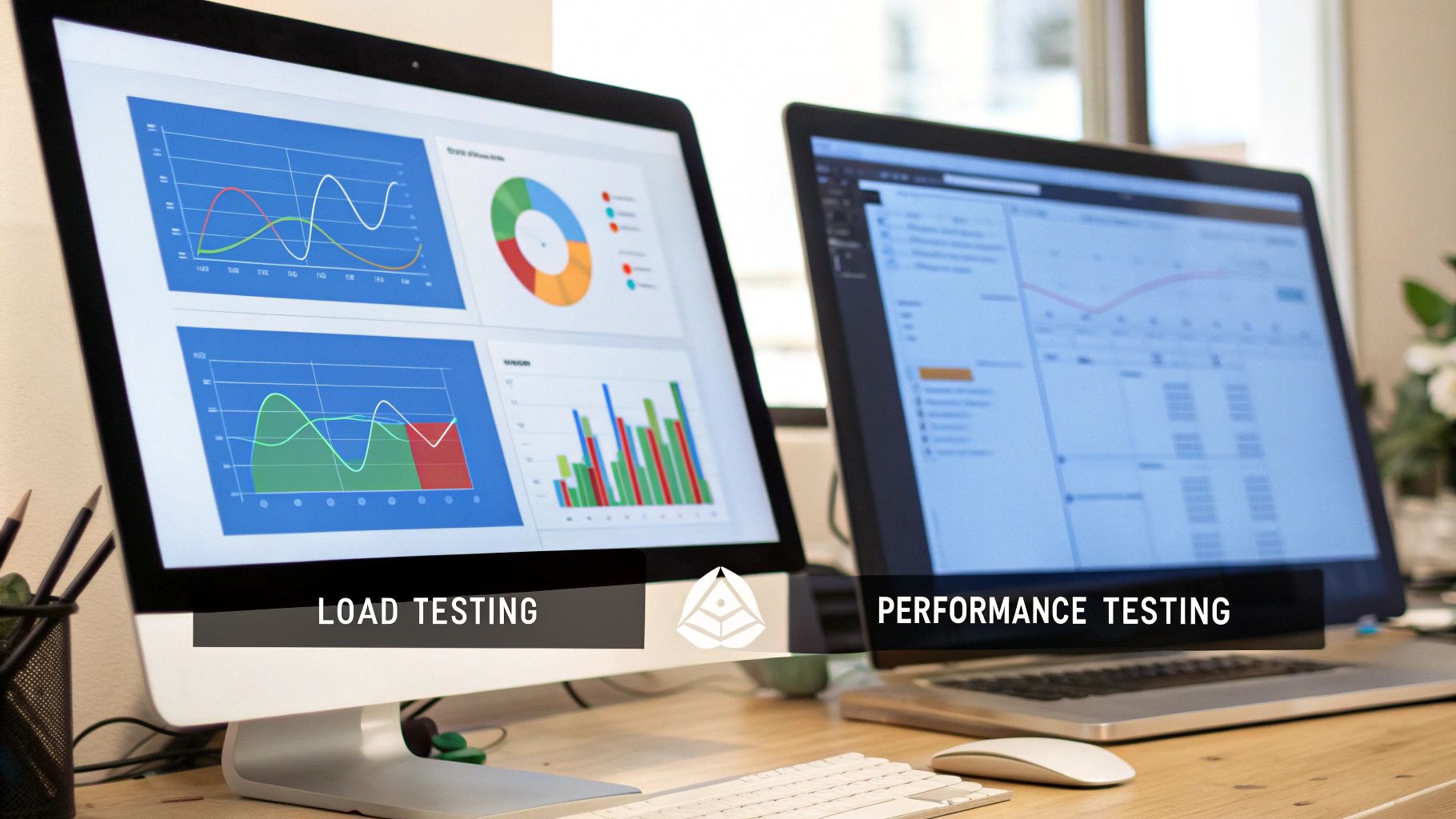The Difference Between Load and Performance Testing: A Modern Testing Guide
Breaking Down Testing Types: Beyond the Basics

Load testing and performance testing serve distinct but complementary roles in evaluating application quality. While they share some common ground, understanding their unique purposes helps teams build more reliable systems. Let’s explore how these testing approaches differ and work together to validate application behavior.
Defining Load Testing
Load testing examines how well a system handles expected real-world usage patterns. By simulating typical user loads, it reveals how the application performs under normal conditions. For instance, an e-commerce site might run load tests with 1,000 concurrent users to match anticipated Black Friday traffic. This helps teams spot potential issues like slow database responses or maxed-out server resources before they affect customers. The focus stays on maintaining performance during typical peak usage rather than extreme scenarios.
Exploring Performance Testing
Performance testing takes a wider view of system behavior, with load testing being just one component. Rather than only checking normal usage, it evaluates how the system runs across many different scenarios and conditions. Teams might test how the application scales up under growing traffic, maintains stability during extended use, or recovers from failures. This broader testing scope helps build a complete picture of the system’s capabilities and limitations.
Key Differences: A Closer Look
This comparison table highlights the main distinctions between these testing types:
| Feature | Load Testing | Performance Testing |
|---|---|---|
| Objective | Assess system behavior under expected load | Evaluate overall system performance under various conditions |
| Scope | Specific load levels | Broader, includes load, stress, scalability, endurance testing |
| Focus | Responsiveness, stability, resource utilization under load | Overall efficiency, scalability, reliability, and other performance aspects |
| Metrics | Response time, throughput, error rate under load | Throughput, latency, resource utilization, error rates, and more |
The table shows how performance testing provides wider coverage while load testing drills deep into specific usage scenarios. For more details, check out our guide on Load Testing vs. Performance Testing: Understanding Key Differences and When to Use.
Why Use Both?
Combining load and performance testing gives teams the most complete view of their application’s behavior. Load tests confirm the system works well for expected traffic, while performance tests reveal how it handles edge cases and unexpected conditions. This two-pronged approach helps catch issues early - from slow response times during peak loads to system crashes under stress. Making both types of testing part of regular development helps teams ship more stable, reliable applications that meet user needs.
Measuring What Actually Matters
Making decisions about system improvements requires clear data about what truly impacts users and business goals. Raw numbers alone aren’t enough - you need to understand which metrics directly affect your system’s success and which ones just look impressive without providing real value. This distinction becomes especially clear when comparing load testing versus performance testing, as each provides unique insights into different aspects of your system’s behavior.
Key Performance Indicators (KPIs) in Load Testing
When measuring how well a system handles expected user traffic, certain metrics become essential indicators. Response time shows how quickly users get what they request - a critical factor since slow responses frustrate users and hurt business. For example, Amazon discovered that every 100ms slower their pages loaded, they lost 1% in sales. Throughput matters too, as it shows how many transactions your system can handle at once. This directly affects your ability to serve users during busy periods. The error rate under load is another vital sign - if too many requests fail, it signals serious problems that need fixing right away.
Critical Metrics in Performance Testing
Performance testing looks at a broader set of measurements to give a complete picture of system health. Beyond the basic indicators used in load testing, it tracks how efficiently your system uses resources like CPU power, memory, and disk space. This helps find bottlenecks and improve resource use. Network latency becomes especially important for applications serving users across different regions. Other key metrics include how many users can connect at once, requests processed per second, and database speed. For example, social platforms need to measure how fast new content reaches users since this directly affects engagement.
Translating Metrics into Actionable Insights
Understanding what different metrics mean in practice helps teams make real improvements. By looking at how various measurements relate to each other, you can spot specific problems. If load tests show slow responses when CPU usage spikes, you might need to optimize your application server. Similarly, high network latency during periods of heavy traffic could point to network congestion issues. Clear metrics guide you straight to areas needing improvement, making optimization work more focused and effective.
Prioritizing Metrics Based on System Needs
While some metrics matter for every system, the most important ones depend on what your application does. Online stores might care most about response times and transaction throughput during sales events. Video platforms focus more on smooth playback through metrics like latency and buffer rates. By matching metrics to business goals, testing efforts stay focused on what matters most for your users. This targeted approach helps turn complex performance data into specific improvements that make your application better and more reliable.
Choosing Your Testing Toolkit
Prioritizing metrics and understanding the nuances between load and performance testing is essential. However, selecting the right tools to gather and analyze that data is equally critical for obtaining accurate and actionable results. Exploring the available performance testing tools can feel daunting, but grasping the strengths and weaknesses of different options empowers teams to make well-informed choices.
Key Performance Testing Tools and Their Uses
Several tools excel at various aspects of load and performance testing. Apache JMeter, a popular open-source option, offers flexibility and extensive community support. This makes it suitable for simulating diverse load scenarios and analyzing a range of performance metrics. For instance, JMeter can simulate thousands of concurrent users interacting with a web application, providing data on response times, throughput, and error rates under heavy load. This helps identify bottlenecks and optimize application performance before a public release.
LoadRunner, a commercial tool, provides robust features for enterprise-level performance testing, including sophisticated scripting capabilities and in-depth performance monitoring. Its advanced analytics dashboard assists in identifying performance issues across complex systems. However, the cost can be a substantial consideration for smaller teams or projects with limited budgets.
Gatling, another open-source choice, excels in performance modeling and simulation. Its code-based approach allows for greater flexibility and integration with development pipelines. Furthermore, Gatling’s detailed reports and visualizations offer valuable insights into system behavior under different load conditions. This emphasis on modeling allows teams to anticipate how their applications will perform with future growth and plan proactively.
GoReplay presents a unique approach by capturing and replaying live HTTP traffic, providing a realistic simulation of user behavior. This method is particularly beneficial for understanding how your system responds to real-world traffic patterns, going beyond synthetically generated load. This can reveal hidden performance issues that might not be apparent during traditional load tests.
Maximizing Impact by Combining Tools
Many high-performing teams capitalize on the strengths of multiple tools. For example, they might use JMeter for foundational load testing and then supplement it with GoReplay to capture and replay real user traffic for more realistic performance insights. This combination offers both a broad overview of system performance under various load levels and a detailed analysis of real-world behavior. In addition, integrating tools like PageSpeed Insights or WebPageTest can further enhance performance analysis by providing client-side performance metrics. This comprehensive approach ensures a thorough evaluation of all factors influencing the user experience.
Avoiding Common Tool Selection Mistakes
One frequent mistake is selecting a tool based solely on popularity or cost without considering specific project requirements. Blindly choosing the most popular tool might lead to wasted time and resources if it doesn’t align with your testing goals. Another pitfall is overlooking the hidden costs associated with open-source tools. While the software itself may be free, consider the time and effort needed for setup, configuration, and ongoing maintenance. Carefully evaluating your requirements, technical expertise, and budget constraints before selecting tools will maximize your testing investment and deliver the most valuable insights into your application’s performance. By understanding the difference between load and performance testing and selecting the appropriate tools, you can ensure a smooth, efficient, and high-performing application for your users.

Connecting Testing to Business Results
Moving beyond metrics and tools, let’s explore how testing directly impacts your business success. When you understand how load and performance testing work together, you can make better decisions that boost user satisfaction and drive sales growth. The right testing approach helps you deliver a smoother experience that keeps customers coming back.
The Impact of Testing on User Satisfaction
Poor performance frustrates users and hurts your business. Slow page loads, errors, and crashes drive people away fast. Load testing helps prevent these problems by simulating real user traffic before issues appear in production. For instance, if your e-commerce site slows to a crawl during a holiday sale, shoppers will abandon their carts and may never return. Regular load testing catches these bottlenecks early so you can fix them before losing customers.
Converting Satisfied Users into Paying Customers
While load testing ensures your site handles regular traffic well, performance testing takes things further by checking how your system behaves under stress. This broader testing helps create the reliable experience that turns visitors into customers. When users can smoothly complete purchases without errors or delays, they’re more likely to follow through and become repeat buyers. Performance testing helps optimize every step of their journey.
Real-World Examples: Testing-Driven Success
Major companies rely on insights from both types of testing to guide their business choices. Testing data helps them decide where to invest in infrastructure and which features need work first. By understanding exactly how their systems perform in different situations, they can focus resources where they matter most. Want to learn more? Check out this guide on How to master performance testing.
The Cost of Inadequate Testing: A Cautionary Tale
Skipping proper testing often costs far more than doing it right from the start. When systems fail or perform poorly, you lose money through downtime, upset customers, and potential legal issues. Making the case for thorough testing means showing the real costs of problems versus the benefits of prevention. Consider factors like lost sales during outages, customers who leave due to poor performance, and the long-term value of maintaining a stable system.
Communicating the Value of Testing to Executives
When talking to executives about testing, focus on business impact rather than technical details. Show how testing helps achieve key goals like increasing revenue and keeping customers happy while reducing operating costs. Instead of treating testing as just another expense, present it as an investment that protects and grows the business. Explain how load testing ensures you won’t lose sales during peak periods, and how performance testing prevents costly outages that damage your reputation. This approach helps secure support for building a solid testing program that drives business growth.
Building Your Testing Strategy Playbook

Now that we understand the key differences between load and performance testing, let’s focus on creating a practical testing strategy that works in the real world. A solid game plan helps teams test systematically rather than randomly, ensuring better results with less wasted effort.
Defining Clear Performance Benchmarks
Start by setting specific, measurable performance goals based on what your users actually need. For example, decide that your application should respond within 200ms for API calls or handle 1000 concurrent users without slowdowns. Think about metrics like page load times, error rates, and server resource usage. Having clear targets helps the whole team understand what “good performance” really means for your application.
Creating a Realistic Testing Schedule
Map out when and how often you’ll run different types of tests throughout your development process. You might run quick load tests weekly during regular development, then do deeper performance testing before major releases. Consider your team’s workflow and resources - there’s no point in scheduling daily tests if you don’t have time to review and act on the results. Focus on testing at key moments like after major code changes or before expected traffic spikes.
Integrating Testing into Your Development Cycle
Make testing a natural part of how your team works by adding it to your Jenkins or other CI/CD pipeline. Set up automated tests that run whenever code changes, so developers get quick feedback if something affects performance. This early warning system helps catch issues when they’re still small and easy to fix, rather than becoming major problems in production.
Balancing Testing Coverage and Resource Constraints
Be strategic about what you test since you can’t test everything all the time. Look at your application’s critical paths - like checkout flows for e-commerce sites or login systems for web apps. These high-impact areas deserve more thorough testing. Also consider which parts of your system are most likely to have performance problems based on past experience. This focused approach helps you get the most value from limited testing time and resources.
Continuous Testing Improvement
Keep refining your testing approach based on what you learn. Review test results regularly to spot patterns and adjust your strategy. Maybe you find that certain API endpoints consistently run slow - that’s a sign to focus more testing effort there. Or perhaps your load tests show that adding caching would help more than adding servers. Stay flexible and willing to change your testing plans as your application and its usage patterns evolve.
Remember that good testing isn’t about following a rigid plan - it’s about consistently gathering useful data that helps you build better software. By combining targeted load testing with broader performance monitoring, you can create a testing strategy that grows with your application and helps prevent problems before users notice them.
Navigating Modern Testing Challenges
Software testing has grown increasingly complex as applications evolve to use cloud services, microservices, and mobile-first designs. Teams need to master both load testing and performance testing to effectively validate modern applications. While these testing approaches complement each other, each provides unique insights that are essential for delivering reliable software.

Testing Distributed Systems: A New Paradigm
Testing distributed systems requires going beyond traditional methods. When application components run across multiple servers and locations, finding performance bottlenecks becomes much more challenging. Load testing alone often misses issues with service communication and data consistency. For instance, microservices may work perfectly in testing but struggle in production due to network delays between services. This shows why performance testing must specifically examine how different parts of distributed systems work together.
The Mobile-First Mandate: Performance on the Go
Mobile users now expect apps to work flawlessly regardless of their device or network connection. This makes thorough mobile testing crucial. While load testing helps simulate many concurrent mobile users, performance testing examines how apps handle varying network speeds, screen sizes, and operating systems. The goal is ensuring a smooth experience across all mobile scenarios - from the latest flagship phones to older devices on slower networks.
AI and Automation in Testing
Teams are using AI and automation to test increasingly complex applications. AI tools can spot patterns in performance data and flag potential issues before they impact users. Automated testing handles repetitive checks efficiently, giving testers more time for strategic work. However, human expertise remains essential for designing meaningful test scenarios and interpreting results, especially when determining how to balance load and performance testing for complex systems.
Embracing Continuous Performance Testing
With continuous integration and delivery (CI/CD) becoming standard practice, ongoing performance testing is now crucial. By including performance tests in the CI/CD pipeline, teams catch issues early in development. Running automated performance checks after code changes reveals their impact on response times and resource usage. This constant feedback helps maintain application speed and stability throughout development.
Meeting these challenges requires thoughtful testing that combines load and performance testing effectively. By understanding when to use each approach and adapting your strategy for modern architectures, you can build applications that consistently deliver excellent performance.
Ready to capture and replay real user traffic to gain valuable performance insights? Try GoReplay today and improve your testing approach. Visit https://goreplay.org to learn more.
